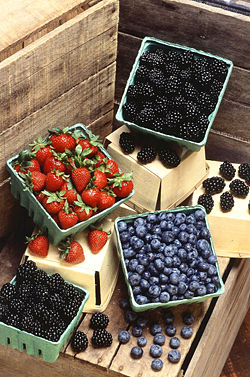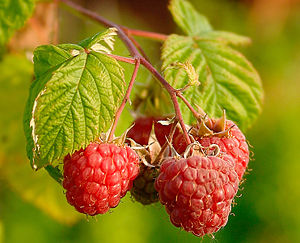Berry
- For the botanical term, see true berry. For other uses, see Berry (disambiguation).
In everyday English, a berry is a broad term for any small edible fruit. Most berries are juicy, round or semi-oblong, brightly coloured, sweet or sour, and don't have a stone or pit. Most berries are edible, but some are poisonous to humans.
True berries are distinguishable from false berries like blueberries and cranberries for which the fruit is formed from other parts of the flower, not just the ovary. Also not true berries, aggregate fruits like raspberries are collections of small fruits, and accessory fruits like strawberries are formed from parts of the plant other than the flower. As explained below, none of these is a true berry.
Contents |
Types of berries
True berries
- Main article: True berry

The blueberry is a false berry, blackberries are aggregate fruit, and strawberries are accessory fruit.
In botanical language, a berry or true berry is a simple fruit having seeds and pulp produced from a single ovary. The true berry is the most common type of fleshy fruit in which the entire ovary wall ripens into an edible pericarp. The flowers of these plants have a superior ovary and one or more carpels within a thin covering and fleshy interiors. The seeds are embedded in the common flesh of the ovary.
The true berries are dominated by the family Ericaceae, many of which are hardy in the subarctic:
- Bearberry (Arctostaphylos spp.)
- Bilberry or whortleberry (Vaccinium spp.)
- Blueberry (Vaccinium spp.)
- Crowberry (Empetrum spp.)
- Cranberry (Vaccinium spp.)
- Huckleberry (Vaccinium spp.)
- Lingonberry (Vaccinium vitis-idaea)
- Strawberry Tree (Arbutus unedo), not to be confused with the actual strawberry (Fragaria)
Other berries not in the Rosaceae or Ericaceae:
- Açaí (Euterpe), a palm fruit native to the Amazon region
- Barberry (Berberis; Berberidaceae)
- Currant (Ribes spp.; Grossulariaceae), red, black, and white types
- Elderberry (Sambucus; Caprifoliaceae)
- Gooseberry (Ribes spp.; Grossulariaceae)
- Hackberry (Celtis spp.; Cannabaceae)
- Honeysuckle: the berries of some species (called honeyberries) are edible, others are poisonous (Lonicera spp.; Caprifoliaceae)
- Mulberry (Morus spp.; Moraceae) including:
- Red Mulberry (Morus rubra)
- White Mulberry (Morus alba)
- Mayapple (Podophyllum spp.; Berberidaceae)
- Nannyberry or sheepberry (Viburnum spp.; Caprifoliaceae)
- Oregon grape (Mahonia aquifolium; Berberidaceae)
- Sea-buckthorn (Hippophae rhamnoides; Elaeagnaceae)
- Sea Grape (Coccoloba uvifera; Polygonaceae)
- Wolfberry (Lycium barbarum, Lycium spp.; Solanaceae)
Not a botanical berry
Many "berries" are not actual berries by the scientific definition, but fall into one of these categories:
- False berries like blueberry and cranberry, are epigynous, made from a part of the plant other than a single ovary.
- Compound fruit, which includes:
- Aggregate fruit are multiple fruits with seeds from different ovaries of a single flower, such as blackberry, raspberry, and boysenberry
- Multiple fruit, being the fruits of separate flowers, packed closely together. The mulberry, for example, is essentially like a cluster of grapes, but tiny and compressed into one "berry"[1].
- Other accessory fruit, where the edible part is not generated by the ovary, such as the strawberry for which the seed-like achenes are actually the "fruit" derived from the ovary.
The bramble fruits, compound fruits of genus Rubus (blackberries), are some of the most popular pseudo-berries:
- Blackberry, of which there are many species and hybrids, such as dewberry, boysenberry, olallieberry, and tayberry (genus Rubus)
- Cloudberry (Rubus chamaemorus)
- Loganberry (Rubus loganobaccus)
- Raspberry, several species (genus Rubus)
- Salmonberry (Rubus spectabilis)
- Thimbleberry (Rubus parviflorus)
- Wineberry (Rubus phoenicolasius)
Modified berries
The fruit of citrus, such as the orange, kumquat and lemon, is a modified berry called a hesperidium.
The fruit of cucumbers and their relatives are modified berries called "pepoes". A plant that bears berries is referred to as bacciferous.
Colour and medical benefits
By contrasting in colour with their background, berries are more attractive to animals that eat them, aiding in the dispersal of the plant's seeds.
Berry colours are due to natural pigments synthesized by the plant. Medical research[1] has uncovered medicinal properties of pigmented polyphenols, such as flavonoids, anthocyanins, and tannins and other phytochemicals localized mainly in berry skins and seeds. Berry pigments are usually antioxidants and thus have oxygen radical absorbance capacity ("ORAC") that is high among plant foods.[2] Together with good nutrient content, ORAC distinguishes several berries within a new category of functional foods called "superfruits" and is identified by DataMonitor as one of the top 10 food categories for growth in 2008[3].
| Botanical parlance | ||||||||
|---|---|---|---|---|---|---|---|---|
| True berry | Pepo | Hesperidium | False berry (Epigynous) | Aggregate fruit | Multiple fruit | Other accessory fruit | ||
| Common parlance | Berry | Blackcurrant, Redcurrant, Gooseberry | Cranberry, Blueberry | Blackberry, Raspberry, Boysenberry | Mulberry | Strawberry | ||
| Not a berry | Tomato, Eggplant, Guava, Lucuma, Chili pepper, Pomegranate, Kiwifruit, Grape | Pumpkin, Gourd, Cucumber, Melon | Orange, Lemon, Lime, Grapefruit | Banana | Hedge apple | Pineapple, Fig | Apple, Peach, Cherry, Green bean, Sunflower seed | |

Notes
- ↑ Journal of Agricultural and Food Chemistry Presents Research from the 2007 International Berry Health Benefits Symposium, Journal of Agricultural and Food Chemistry ACS Publications, February 2008
- ↑ Wu X, Beecher GR, Holden JM, Haytowitz DB, Gebhardt SE, Prior RL (2004-06-16). "Lipophilic and hydrophilic antioxidant capacities of common foods in the United States". J Agric Food Chem 2004 Jun 16;52(12):4026-37.. Retrieved on 2007-07-31.
- ↑ Fresh, super and organic top trends for 2008, FoodNavigator.com-USA, November 2007
See also
- List of fruits
- Epigynous berry
- Accessory fruit
- Aggregate fruit
- Multiple fruit
External links
- The National Council for the Conservation of Plants and Gardens - Description of berries
- Encarta.msn.com - Differentiation between true berries, pepos, and hesperidia
- United States National Berry Crops Initiative
- Berry Health Benefits Network - Scientists working on the health properties of berries
|
|||||
